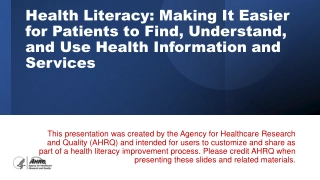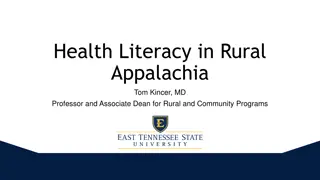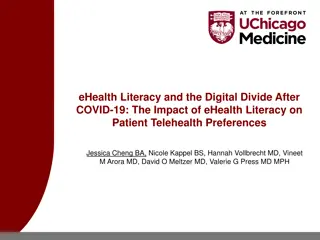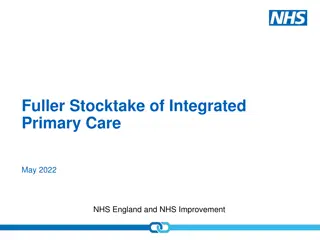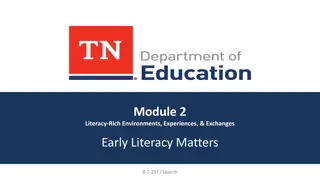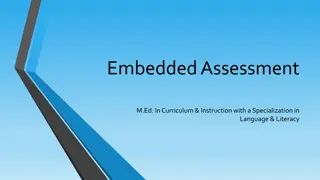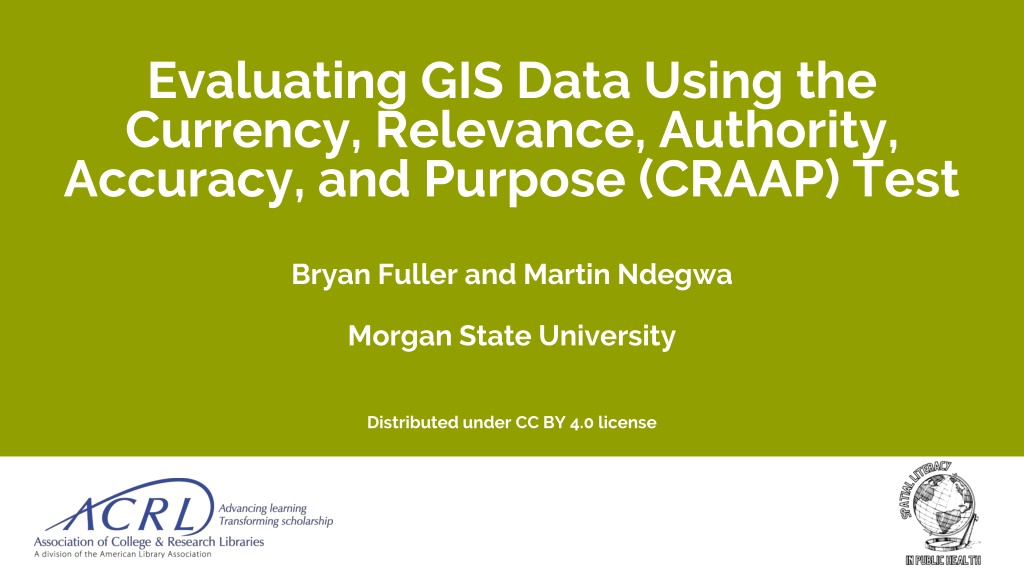
Evaluating GIS Data Using the CRAAP Test Overview
This presentation introduces the Currency, Relevance, Authority, Accuracy, and Purpose (CRAAP) Test for evaluating GIS data to make informed decisions on spatial data selection. It covers the importance of assessing the currency, relevance, authority, accuracy, and purpose of data sources in spatial literacy. The CRAAP Test is a versatile framework applicable across all disciplines and can enhance information literacy skills. Specific focus is given to criteria such as timeliness, relevance, and reliability in GIS data evaluation.
Download Presentation

Please find below an Image/Link to download the presentation.
The content on the website is provided AS IS for your information and personal use only. It may not be sold, licensed, or shared on other websites without obtaining consent from the author. If you encounter any issues during the download, it is possible that the publisher has removed the file from their server.
You are allowed to download the files provided on this website for personal or commercial use, subject to the condition that they are used lawfully. All files are the property of their respective owners.
The content on the website is provided AS IS for your information and personal use only. It may not be sold, licensed, or shared on other websites without obtaining consent from the author.
E N D
Presentation Transcript
Evaluating GIS Data Using the Currency, Relevance, Authority, Accuracy, and Purpose (CRAAP) Test Bryan Fuller and Martin Ndegwa Morgan State University Distributed under CC BY 4.0 license
ABOUT Informed decision-making about spatial data selection and reliability is a fundamental part of spatial literacy. The proliferation of spatial data on the internet and the large quantity of user-generated data increases the hazards of the data search and selection process. The CRAAP (Currency, Relevance, Authority, Accuracy and Purpose) Test is a straightforward and adaptable approach to evaluating different modalities of literacy. This presentation will give students an guidance on using the CRAAP Test when evaluating spatial data across multiple domains.
The CRAAP Test The CRAAP Test is a flexible and general framework for evaluating information resources. Developed in 2004, and oriented primarily to the needs of first-year college students, the test is an easy-to-use checklist for evaluating information resources across all disciplines. It has become a standard tool in information literacy as it demonstrates flexibility across many adaptations and venues. The basic concepts of the CRAAP test can be expanded to examine how they can be used to evaluate data sources in GIS.
Currency Timeliness of the Information: When was the data published or posted? Has the data been revised or updated? Does your research topic require the most current data, or will older sources work as well? Currency refers to both how recent data are, and also to when it was updated. Some data providers might revise existing data sources instead of creating new ones with every update. When evaluating the currency of a dataset use the questions to the right to get an idea of when the data was created, when it was revised, and if it is current enough for your needs.
Currency The record to the left presents multiple and conflicting indicators about the currency of the dataset. The Date Created field shows 2011, while another field at the top indicates that it was updated in 2008. Is this dataset from 2008, 2011 or 2017? Why are there so many conflicting dates for this dataset? When searching for spatial data, you may not find a definitive answer, and might have to reach out to the data curator
Relevance Importance of the Information for Your Needs The relevance of data is determined by the project research questions including things like study area, spatial unit of analysis, and the populations or phenomenon being studied. Does the data relate to your topic or (help to) answer your question? For whom is the data s intended? Is it the general public or a specialist community? In GIS, this criterion can be expanded to include selecting a data model, scale, and cartographic considerations. Have you looked at a variety of data sources before determining which one you will use? Would you be comfortable citing this data source in your research? Adding data like street lines and other infrastructure can give context to an analysis and make the map more effective at communicating spatial patterns. Use the questions to the right to help determine the relevance of a data source for your project.
Relevance Selecting relevant data also requires comprehensive familiarity with available data, including what the data represent and, equally important, what they do not represent. For example, For effective analyses, we have to know the answers to the following questions: Is the population with no private insurance equal to the population with no insurance plus the population with public insurance? Is the population with no public coverage equal to the population with private insurance plus the population with no health insurance? when searching for ACS data about health insurance status and poverty level, we can find three tables and a sample of their attributes: C27016. Health Insurance Coverage Status by Ratio of Income to Poverty Level in the Past 12 Months by Age Under 1.00 of poverty threshold 19 to 64 years with health insurance coverage Under 1.00 of poverty threshold 19 to 64 years no health insurance coverage C27017. Private Health Insurance by Ratio of Income to Poverty Level in the Past 12 Months by Age Under 1.00 of poverty threshold 19 to 64 years with private health insurance Under 1.00 of poverty threshold 19 to 64 years no private health insurance C27018. Public Health Insurance by Ratio of Income to Poverty Level in the Past 12 Months by Age Under 1.00 of poverty threshold 19 to 64 years with public coverage Under 1.00 of poverty threshold 19 to 64 years no public coverage
The Reliability, Truthfulness, and Correctness of the Content. AUTHORITY Who is the author/publisher/ source/sponsor of the data? GIS data sources are often authoritative implicitly because the cost and time required to create them can be sustained only by institutions and technical experts. What are the data creator s credentials or organizational affiliations? GPS tracking applications and online mapping venues like Google Maps have made GIS accessible to everyone. In the hands of laymen, these applications are very useful for visualizing spatial data but may lack any quality control, and the data may not conform to privacy requirements or may come from an unauthorized source; the data creator may even be anonymous or pseudonymous, making an effective evaluation of authority impossible. Is the author qualified to create data for a specific topic? Is there contact information, such as a publisher or email address in the record? Does the URL reveal anything about the author or source? (Examples: .com, .edu, .gov, .org, .net) Use the questions to the right to help you evaluate the authority of a dataset.
To the far left is a user- generated shapefile of Baltimore Police Districts, with a detail, near-left. The detail shows that there are significant data quality issues, including overlapping boundary and dangling nodes, making this marginally useful as a visualization, but unsuitable for any analysis. An authoritative source must be identified to supply the required data to guarantee other aspects of the CRAAP Test.
The Reliability, Truthfulness, and Correctness of the Content. ACCURACY Where does the data come from? (This is just like authority) Is the data supported by evidence? Has the data been reviewed or refereed? Can you verify any of the data from another source or from personal knowledge? Are there typographical or other data errors? Accuracy is the most expansive criterion in the context of GIS. As Bolstad* states, An accurate observation reflects the true shape, location or characteristics of the phenomenon represented in GIS (p. 621) and further defines four parameters of accuracy in GIS: Positional Accuracy: how close the GIS model is to the real location. Attribute Accuracy: or statistical errors between the attribute data and the population based population-based on sampling. Logical Consistency: or the presence or lack of paradoxes, such as a building site that is located in a water body. Completeness: how well the data reflect the frequency of real-world phenomena. *Bolstad, Paul. GIS Fundamentals: A First Text on Geographic Information Systems. 3rd ed. Ann Arbor, MI: XanEdu Publishing Inc., 2019.
Generalization is an implicit source of error in spatial data. Because vector and raster data are models, or generalizations of real-world phenomena, there is naturally a loss of detail and precision between them and spatial reality, when vector data, for example, are digitized at a too-small scale or raster data are captured at a too-large resolution. The selection of more generalized data is influenced by computational constraints of hardware, like processing speed and hard- drive space; and cartographic considerations for highly detailed data that are difficult to interpret at small scales. The image left compares detailed (far left) and generalized (near left) shapefiles of U. S. Counties on the East Coast. The detailed shapefile is not well suited to small scales because the detail is cluttered on the coastal areas especially. The generalized shapefile presents a much cleaner look.
In contrast, when zoomed in to larger scales, the generalized shapefile, far left, appears clumsy and abstract, while the detailed shapefile, near left, shows amore realistic representation of the study area. There are many aspects of GIS for which accuracy is important. What are some of them and why do you think they are important? Are there possible ways to evaluate accuracy of attribute data?
Attribute Accuracy and the Margin of Error- The American Community Survey (ACS) What is the ACS? A vital source of sociodemographic data for researchers. - Provides estimates, not actual counts, with statistical uncertainty. - Integral for understanding demographic trends and informing policy. Key Features: - Collects data on various demographic, social, economic, and housing characteristics. - Estimates contain a margin of error (MOE), reflecting the degree of statistical uncertainty. - Data is reported at the 90% confidence level.
Understanding and Navigating Margin of Error (MOE) in ACS Data What is MOE? - Indicates the reliability of ACS estimates. - Provides a range where the actual value most likely falls (upper and lower limits). Importance of MOE: - Essential for assessing the accuracy and reliability of ACS data. - More prominent in small areas, sub-groups, or cross-tabulated demographic characteristics. Challenges and Ethical Considerations: - Users often overlook MOE in policy-specific decision-making. - Important to communicate statistical uncertainty to clients, policymakers, and the public. - Follow guidelines for ethical use: report MOEs, provide context, consider alternatives, and conduct statistical tests when comparing estimates.
Attribute Accuracy and the Margin of Error Why is Margin of Error important? How can public policy and health care planning especially, be confounded by analyses that do not consider the margin of error? Do you know how to evaluate the margin of error and decide which spatial units to use in the American Community Survey? Can you tell if a dataset is a sample (collects a part of the population) or a census (collects total population).
PURPOSE The Reason the Information Exists Does the data represent fact or opinion? Like all information, every dataset has an agenda behind its creation. What agenda does the data creator have? The evolution of the U. S Decennial Census is a good example of how data collection is motivated by changing priorities. The original mandate in the enumeration clause of the Constitution (U.S. Const. Art. 1 1 & 2) was to count the population. However, motivated in part by the industrialization of the economy and changing demographic characteristics of the population in the mid-nineteenth century, the Census has expanded its range of data collection, and now includes extensive surveillance with the American Community Survey intercensal data which provides data more representative of current and economic conditions and provide more responsive funding. Is it biased? Does the data creator or agency seem to push an agenda or a particular side? Is the data creator trying to sell something? If so, is it clearly stated?
PURPOSE Baltimore s neighborhoods are defined according to the shapefile provided by the Maryland state government. In this figure, we can see (in red) the outline of Baltimore s Highlandtown neighborhood. However, interviews with neighborhood residents reveal the perception that the actual boundaries of Highlandtown, in red hachure, extend further north. Data generated through Participatory GIS present a challenge to the CRAAP Test with regard to authority but can also provide the most relevant and current data available. The act of participation denotes a collaboration between laypeople (often stakeholders) and experts who can ensure measures of quality control like accuracy.
Follow Up Questions What is the purpose of the CRAAP test, and why is it important in evaluating GIS data sources? How does the CRAAP test help in ensuring the quality and reliability of GIS data? What are some limitations of the CRAAP test when applied to GIS data evaluation? What are the potential consequences of not using a systematic evaluation method like the CRAAP test for GIS data?
Follow Up Questions How does the CRAAP test contribute to the overall integrity and credibility of GIS analyses and projects? What challenges might students face when applying the CRAAP test to GIS data, and how can they be addressed? How do the components of the CRAAP Test work together? For example we saw the accuracy and authority are closely related because accurate data sources are created by reliable authorities.

